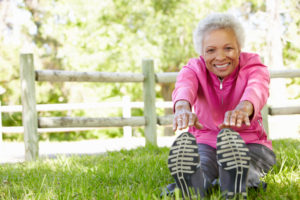Treating the Aches and Pains of Osteoarthritis | by

Whether you are a former professional athlete, like Broncos football player Mark Schlereth, an active person or even a couch potato, you may be among the 30 million Americans suffering from osteoarthritis, according to the Centers for Disease Control and Prevention.
Osteoarthritis (OA) is a degenerative disease that causes stiff and achy joints for some. But, for others it can be debilitating, making daily tasks impossible.
“Osteoarthritis is the most common kind of arthritis,” says Dr. Lisa Corbin, who specializes in integrative medicine at UCHealth. “Its causes can be many. It can be age-related, genetic and caused by wear and tear.”
OA occurs when the cartilage and cushion between joints wears down over time, leading to stiffness, inflammation, loss of flexibility and pain. Although OA can affect any joint in the body, Dr. Scott Resig, an orthopedic surgeon who works at Sky Ridge Medical Center, says the knees, hands, hips, and spine are most commonly affected.
“It is affecting patients at younger ages because we are a more active society,” Resig says. “People are wearing out their joints faster.”
Those who have repeated injuries, excessive wear and tear, a family history of OA, or are overweight have a higher likelihood of developing OA.
Diagnosis
“Some aches and pains are normal with aging and activity, but if the pain and swelling last two weeks or more, see your primary care doctor or orthopedic surgeon to screen for osteoarthritis,” Resig says.

Non-surgical treatment is usually recommended first, while surgery is the last recourse. Your doctor will conduct a functional assessment and, depending on the severity of symptoms, may also take labs or x-rays.
First-Line Treatments
Things that can make living with OA easier include losing weight, exercising, modifying diet and managing pain.
Maintain Weight – “One of the most important things people who have osteoarthritis, and even those who don’t, can do is to maintain a normal body weight,” Corbin says. “It helps reduce the stress on the joints.”

Diet – To help people manage weight and reduce inflammation, Amy Weiman, a registered dietitian with The Medical Center of Aurora, recommends arthritis sufferers eat more omega-3 rich foods such as cold water fish, nuts, seeds, and foods naturally high in fiber to boost the body’s anti-inflammatory responses. She also advocates a mainly plant-based diet, rich in antioxidants with less fat, sugar, alcohol, and processed foods. Dr. Elizabeth Sebestyen, an internal medicine doctor with Presbyterian/St. Luke’s Medical Center, advises her OA patients try a three week diet excluding sugar, dairy and grains to see if it makes a noticeable difference. Many report positive results.
Supplements and Natural Relief – Corbin says supplements like glucosamine chondroitin can be helpful, “Take 1500 mg per day and try it for at least six weeks to determine if it has noticeable effects.” Other supplement that may help OA sufferers are SAMe, S-adenosyl-L-methionine, (400 mg, two times a day), or fish oil supplements (2 grams, once a day). She says stay away from willow bark since it’s harsh on the stomach. Topical pain relief such as arnica or herbal plasters can also soothe aches and painful areas.

Medications – “People respond differently to pain medications and what works for some may not for others,” Resig says. Acetaminophen is an analgesic and may help with pain but NSAIDS (nonsteroidal anti-inflammatory drugs) such as naproxen or ibuprofen are better for inflammation and swelling. Corbin recommends acetaminophen as a first choice because it is easier on the stomach and kidneys, especially for those over 50, who should take acid blockers if taking medications like ibuprofen to reduce risk of ulcers.
Doctors may also prescribe stronger meds or recommend injections. Steroid injections may provide quicker relief and can last weeks to months. For the knee joint, hyaluronic acid injections can last six months or longer, but are less helpful when there is bone-on-bone arthritis. Resig says hyaluronic acid may take a few weeks to start working but the more advanced the arthritis, the less effective the injections will be.
Joint Replacement?

Historically, doctors would discourage a patient from considering replacement until age 65. But, with advances in technology, people are functioning better and for longer after joint replacement. Resig says more people in their 50s are opting for surgery because there are too many drawbacks to waiting: inactivity can lead to weight gain, other health problems, depression, and the possibility of permanent deformities developing in joints that could limit full range of motion.
- “A simple x-ray can give answers and is a good starting point for patients,” he says.
- 1 in 2 adults develops symptoms of knee OA during their lives.
- 1 in 4 adults develops symptoms of hip OA by age 85.
- 1 in 12 people 60 years or older have hand OA.
Source: Arthritis Foundation
Tags: Presbyterian St. Luke's, Sky Ridge Medical Center, The Medical Center of Aurora
Leave a Comment
Please be respectful while leaving comments. All comments are subject to removal by the moderator.

